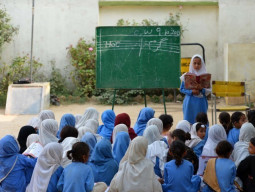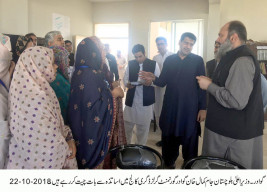
According to the report, 19 per cent of women and 48 per cent of men in Balochistan, 28 per cent of women and 59 per cent of men in Khyber Pakhtunkhwa (K-P), 43 per cent of women and 62 per cent of men in Sindh, 47 per cent of women and 61 per cent of men in Punjab.
Malala advocates free education for girls at WEF
While the gender disparity is more pronounced in Balochistan and K-P, it exists throughout the country.
“In interviews for this report, girls talked again and again about their desire for education, their wish to 'be someone', and how these dreams had been crushed by being unable to study.”
The report ties low education rates for girls to broader gender inequality in the country, citing Pakistani activists’ estimate that there are about 1,000 honour killings every year and twenty-one per cent of females marry as children.
Thus recommendations include ending child marriage by raising the national minimum age of marriage to 18 and ensuring curriculum is gender-sensitive and includes comprehensive sexuality education.
Families, where children were less educated than their parents and younger siblings less educated than older ones, was a concerning theme highlighted by the report.
Barriers
Within the school system, barriers to universal education include a lack of government investment in education and a short supply of government schools especially at higher levels with fewer secondary schools than primary schools and even fewer colleges. This particularly affects girls because schools tend to be gender segregated as students get older and there are fewer for girls.
Go to school: Education ambassadors to push girls enrollment
High costs of education including not only tuition but associated costs such as textbooks, stationery and uniforms; poor quality of education within the schools to the point that some see sending their children as a pointless endeavour; use of corporal punishment and abusive behaviour by teachers; corruption in the forms of nepotism and bribery.
Outside of the school system, the report identifies barriers such as poverty, child labour, gender discrimination, harmful social norms, and insecurity and dangers on the way to school.
“In 2016, the government determined that about 60 million Pakistanis—6.8 to 7.6 million families—were living in poverty, about 29.5 per cent of the country’s population.”
This leads to situations where children – usually girls – are out of school because they are working or staying at home to do housework. Often social norms dictate that girls should not be educated beyond a certain age or at all.
Harmful gender norms include families prioritising boys’ educations as daughters will not contribute income once they are married. The report also identifies child marriage as both a consequence and cause of girls not attending school.
“In Pakistan, 21 per cent of girls marry before age 18, and 3 per cent marry before age 15.”
Another is the insecurity families feel in sending girls to school which include crime and sexual harassment. Communities where such incidents occur remember them for a long time and are hesitant to send girls to schools for long after.
Failure to educate girls could cost world $30 trillion a year-report
“Many girls experienced sexual harassment on the way to school, and police demonstrate little willingness to help prevent harassment. Girls sometimes hesitate to complain about harassment out of fear they will be blamed, or their parents’ reaction will be to take them out of school.”
Recommendations
The report recommends that the federal government take a greater interest in and investment in education. This includes increasing expenditure in accordance with UNESCO guidelines, strengthening provincial oversight in providing data and monitoring enrolment and attendance, work with provincial government improve the quality of government schools.
Provincial authorities to tackle the discrepancy in girls’ education which includes construction and rehabilitation of schools, training and recruitment of female teachers, helping poor families meet school expenses and implement methods such as meal programs or food distribution to increase enrolment of girls.
"Support efforts to develop sustainable solutions to increase girls’ participation in education, including by developing strategies to develop and expand innovative models such as community-based classes in remote areas, schools targeting disadvantaged populations, and schools designed for children who combine education and work."









































COMMENTS
Comments are moderated and generally will be posted if they are on-topic and not abusive.
For more information, please see our Comments FAQ